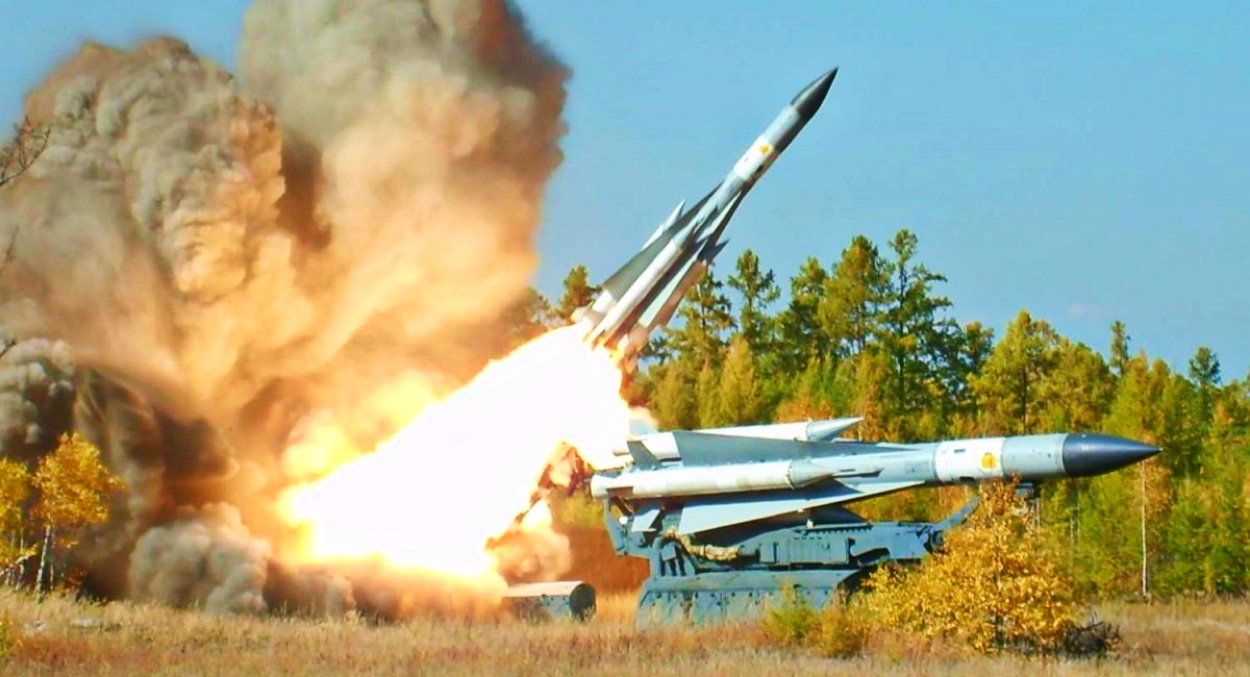Putting all speculations surrounding the recent shootdown of the Tu-22M3 Backfire bomber to rest, the UK Ministry of Defense (MoD) claimed that the bomber was shot down using the S-200 air defense missile and not the Patriot as widely predicted by military watchers on both sides.
After a spate of deadly airstrikes carried out by Russia in the past few days, the Ukrainian forces exacted their revenge by taking down a vaunted Tu-22M3 bomber used to launch long-range missiles on Ukraine on April 19. The bomber was returning to base after conducting an aerial strike when it was struck by the Armed Forces of Ukraine (AFU).
There was jubilation among Ukrainian forces and military watchers as it was the first loss of the Soviet-era bomber in the air. The crash took place in the morning, right after an attack on Ukraine’s Dnipropetrovsk Oblast. The Russian bomber was on fire and in a flat spin as it came down.
The UK MoD published an elaborate intelligence update on April 20, stating that it was highly likely that Ukraine’s air defense forces used the S-200 to bring the Tu-22M3 bomber.
Russia, for its part, stated that the bomber crashed due to some technical malfunction. The shoot-down of the S-200 remained in the headlines over the weekend, with counterclaims that it was not the Soviet-era air defense system that accomplished the stunning hit.
Latest Defence Intelligence update on the situation in Ukraine – 20 April 2024.
Find out more about Defence Intelligence's use of language: https://t.co/Adbu0Dm7LT #StandWithUkraine 🇺🇦 pic.twitter.com/1J99crmNSX
— Ministry of Defence 🇬🇧 (@DefenceHQ) April 20, 2024
Some bloggers argued on Platform X that the bomber was flying more than 400 kilometers away from the frontline—clearly beyond the range of an S-200 missile.
Military commentators also questioned the authenticity of Ukrainian claims by observing the aircraft. Military analyst and avid Russian military watcher Squadron Leader Vijainder K. Thakur reasoned that an aircraft hit by a missile would lose control and enter a high-speed descent as it crashes instead of going down in a flat spin.
“The video shows the crippled Tu-22M3 coming down in a flat spin from great height. Typically, an aircraft needs to be at slow airspeed to enter a flat spin. The crew likely abandoned the aircraft at great height, something they would do under hopeless flight recovery conditions. Loss of thrust and engine fire would best explain early abandonment and consequent entry into a flat spin. A large warhead missile hit would result in loss of control followed by a high-speed descent and crash, not a flat spin,” Thakur noted.
As soon as the shootdown was reported, some preliminary reports suggested that the Ukrainian intelligence agency (GUR) had shot down a rare Russian Air Force Beriev A-50 radar plane on February 23 using the same missile that it used to attack the bomber. This led to conjectures that the weapon could be a Patriot or an S-200.
The UK MoD intelligence update touched upon the speculations, saying, “This system is likely the same system used to shoot down a Russian A-50 MAINSTAY on 23 February 2024,” while referring to the S-200 air defense system.
The information regarding the destruction of the A-50 Mainstay in February is significant. Like the recent shooting down of the bomber, the Ukrainian Armed Forces and Ukrainian intelligence services collaborated to shoot down the A-50 AWACS aircraft in February, causing a massive setback to the Russian Air Force. At that time, the weapon used was not revealed.
⚡️The 🇺🇦Ukrainian military shot down (?) a 🇷🇺Russian Tu-22M3 long-range strategic missile-carrying bomber for the first time pic.twitter.com/wZaUfbWJLi
— 🇺🇦Ukrainian Front (@front_ukrainian) April 19, 2024
Ukraine’s chief of military intelligence, Kyrylo Budanov, said the Tu-22M3 bomber was struck at a distance of 308 kilometers. ”We were waiting for it to reach the right frontier. Fruitful and long work makes itself felt. (The plane was struck) with the same methods and tools that we used to destroy the A-50 in the air.”
The A-50 was flying over 200 kilometers away from the Ukrainian frontline when an S-200 reportedly struck it.
If the information is accurate, the Ukrainian S-200 is responsible for shooting down two of the Russian Air Force’s most strategic and heavy aircraft, which several avid military watchers have attributed to the US-origin Patriot. Some pro-Ukrainian bloggers hailed this as Ukraine’s combat win despite a dearth of Western missile defenses, such as the Patriot.
S-200 In Ukraine’s Arsenal
Developed in the Soviet Union, the S-200, often referred to as SA-5 Gammon, is a long-range surface-to-air missile system that was initially used in the late 1960s. The system has undergone multiple updates since then.
Soviet engineers developed the weapon system in the 1950s to counter the US B-58 supersonic bomber, U2 spy plane, and other reconnaissance aircraft. Ironically, it is now shooting down Russian bombers instead.
The systems could employ a variety of missile modifications. The most recent model had a maximum range of 300 kilometers and could counter air targets up to 40 kilometers in the air.
Before Russia invaded Ukraine, it had four operational S-200 batteries, which consisted of around 24 launchers. Additionally, there were 12 inactive sites in Ukraine. Some of these sites are believed to be legacy systems that came under Ukrainian control after the dissolution of the Soviet Union. However, other reports suggest that Ukraine may have acquired an undisclosed number of S-200V launchers from Russia in 2010.

On October 4, 2001, the Ukrainian S-200 weapon system gained significant attention due to a tragic incident. At that time, the Ukrainian military accidentally shot down Siberia Airlines Flight 1812, traveling from Tel Aviv to Novosibirsk.
During an air defense exercise near the Crimean coast in the Black Sea, two anti-aircraft missiles were launched, one from an S-200 and another from an S-300 system, targeting a drone. As planned, the S-300 missile effectively intercepted the drone. The S-200 missile struck the Russian Tu-154 commercial airliner after it strayed from its intended path and traveled an extra 240 kilometers.
All 78 of the passengers and crew members on board died as a result of the horrific accident that happened while the plane was flying 35,000 feet above the Black Sea.
Despite the accident and the considerable old age of this system, its combat prowess has not diminished. According to an earlier Forbes report, “Ukraine pulled obsolete S-200 surface-to-air missile systems from long-term storage.” It proceeded to replace the command-guidance units in their V-860/880 missiles with GPS seekers, effectively transforming them into surface-to-surface missiles, and subsequently commenced firing these missiles at targets located within Russia.
It is one of the few air defense systems in Ukraine’s arsenal that can hit targets in Russian territory. As NATO’s delivery of additional Patriot batteries remains elusive, the Ukrainian S-200 keeps the Russians at bay.
- Contact the author at sakshi.tiwari9555(at)gmail.com
- Follow EurAsian Times on Google News




